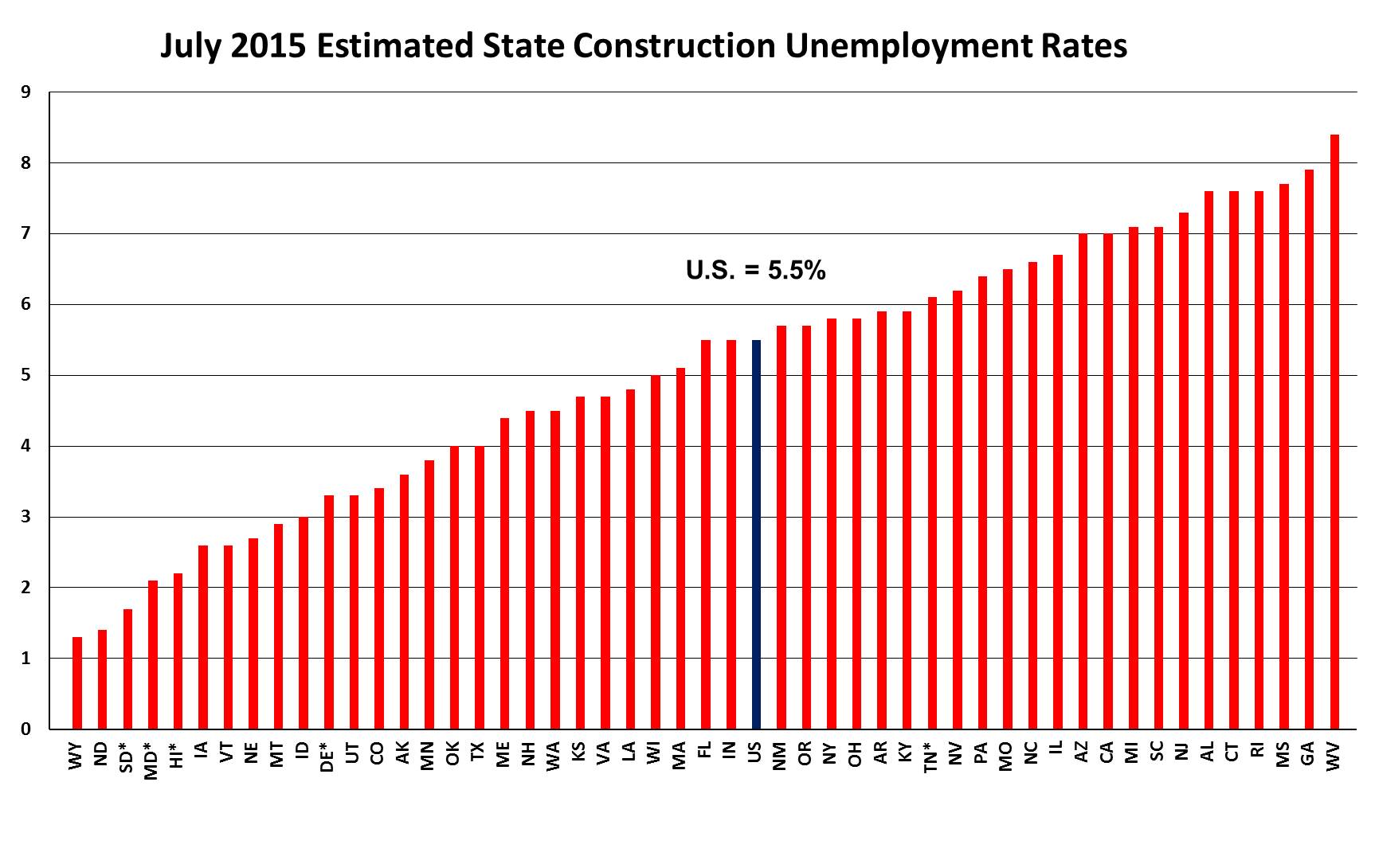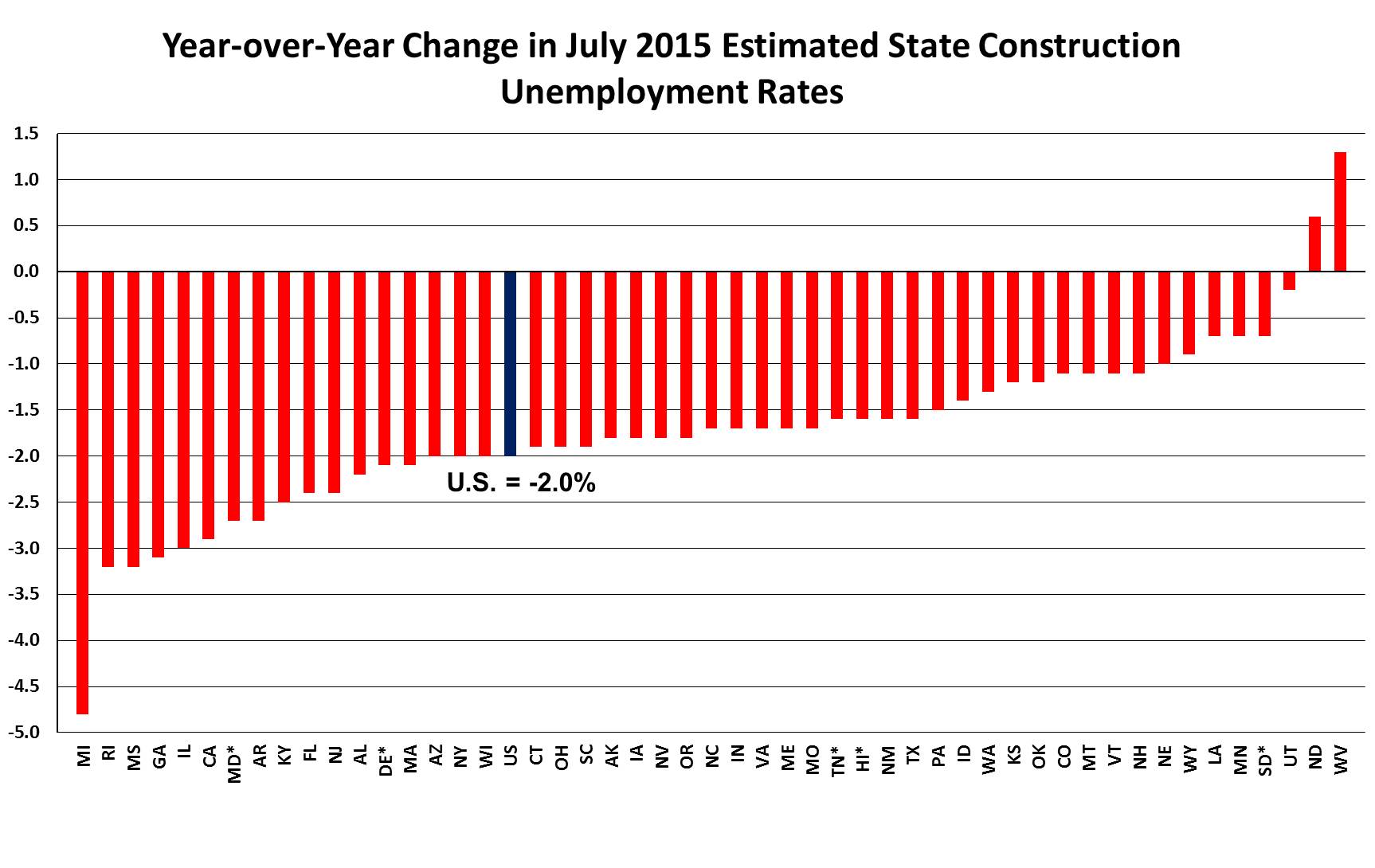July Construction Unemployment Rates Improve in 48 States from 2014
By Bernard M. Markstein, Ph.D.
Overview
Overall employment and construction employment improved nationally in July on a seasonally adjusted (SA) basis. Meanwhile, as would be expected, not seasonally adjusted (NSA) construction employment increased from June. This resulted in 43 states posting a monthly decline in their estimated NSA construction unemployment rate.
With construction activity and employment continuing to advance from last year, the NSA construction unemployment rates for the country and 48 states were down in July on a year-over-year basis. Also, for the second month in a row, all state construction unemployment rates were under 10 percent.
For the first seven months of the year, construction added 108,000 SA jobs. At the same time, NSA jobs increased by 225,000 from July 2014 to July 2015.
View states ranked by their construction unemployment rate.
View states ranked by their year-over-year improvement in construction employment.
View each states' unemployment rate for all industries.
The Top Five States
The five states with the lowest construction unemployment rates in order were:
1. Wyoming
2. North Dakota
3. South Dakota*
4. Maryland*
5. Hawaii*
* Unemployment rate is for construction, mining, and logging combined
Three of the top five states—Wyoming, North Dakota, and South Dakota—were also among the top five in June with a somewhat different order. Wyoming jumped to number one from number five in June based on revised data (Wyoming was previously reported as number six in June).
North Dakota retained its number two position based on revised data (it was previously reported as number three). Note, however, that on a year-over-year basis its rate increased by 0.6 percent. North Dakota and West Virginia were the only two states to experience a rise in their construction unemployment rate from a year ago. For both states, lower energy prices appear to have played a major role in the increase. In North Dakota’s case, lower prices led to a reduction in exploration and drilling new oil wells. In West Virginia’s case, environmental concerns along with the lower energy prices have taken a toll on the coal industry, a major contributor to the state’s economy.
South Dakota fell from number one to number three. Maryland shot up to fourth place from eleventh place in June. Hawaii advanced from tied with Utah for ninth in June to number five in July.
Montana, which was ranked third in June based on revised data (previously reported as tied for fourth), slumped to ninth place in July. Idaho, which was originally tied with Montana for fourth lowest rate, had its rank lowered to sixth lowest in June based on revised data. In July, it fell to the 10th lowest rate. Nebraska sank from fourth place in June to eighth place in July.
View the top five and bottom six states ranked by construction unemployment rate.
The Bottom Six States
The six states with the highest construction unemployment rates (from lowest to highest) were:
47. Alabama, Connecticut, and Rhode Island (tie)
48. Mississippi
49. Georgia
50. West Virginia
Four of the six states with the highest construction unemployment rates in July—Rhode Island, Mississippi, Georgia, and West Virginia—were among the five highest in June. West Virginia had the highest construction unemployment rate in both June and July. Its June ranking is based on revised data. Previously, it had been ranked second highest along with Georgia.
Despite a sharp decline in its construction unemployment rate (down 1.3 percent from the month before and 3.1 percent from the year before) Georgia had the second highest rate in July after posting the third highest rate in June (originally reported as tied for second highest with West Virginia).
Mississippi improved to the third highest rate in the nation from the second highest rate in June, based on revised data. Previously, Mississippi was listed as the highest rate in June.
Rhode Island held its fourth highest position in July. The Ocean State was joined in this ranking by its neighbor Connecticut and Alabama. This was quite a drop for Connecticut, which was 17th highest (34th lowest) in June. Connecticut was one of five states, along with Idaho, Kansas, Minnesota, and Montana, that experienced an increase in its construction unemployment rate from June. Alabama was eighth highest in June.
In June, New Jersey had the fifth highest construction unemployment rate (based on revised data) along with New Mexico. For July, New Jersey came in at seventh highest while New Mexico improved to 22nd highest, tied with Oregon.
View regional breakdowns of the construction unemployment rates of each state.
Special Note and Correction
In past articles and tables, the estimated unemployment rates for six states—Delaware, Hawaii, Maryland, Nebraska, South Dakota and Tennessee—were reported as unemployment rates for construction and mining rather than construction alone. The estimated unemployment rates were actually for construction, mining, and logging combined. The term “logging” was inadvertently left out of these articles and tables.
The reason for producing this combined unemployment rate is that for these states the Bureau of Labor Statistics (BLS) combines data for these three industries in their monthly reports of state industry employment. Those numbers are an input into the model used to produce the state construction unemployment rates (there is a model for these states and a separate model for the construction only states).
After digging deeper into the available BLS data, it is now possible to produce a construction unemployment rate for Nebraska as opposed to the combined rate for construction, mining, and logging. Starting with this report, all estimates of the construction unemployment rate for Nebraska (including all months back through January 2004) will be for construction alone, not the combined rate. Previous articles and tables will not be revised and will continue to show the previously published combined unemployment rates for Nebraska.
To better understand the basis for calculating unemployment rates and what they measure, see the article Background on State Construction Unemployment Rates.

